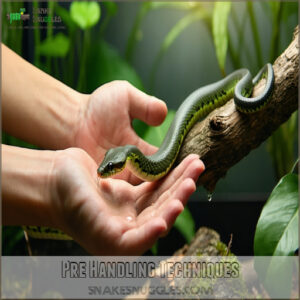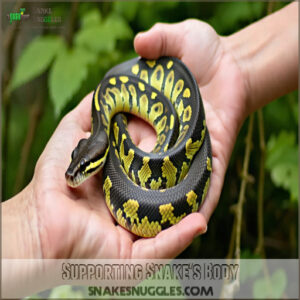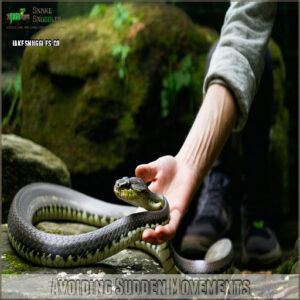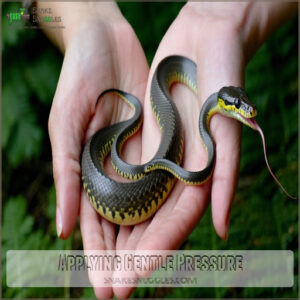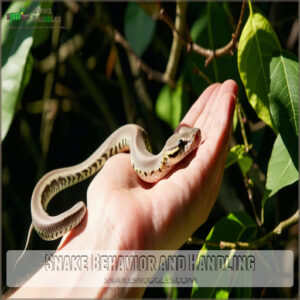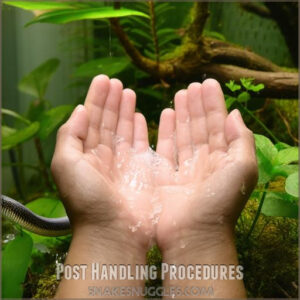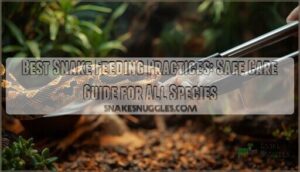This site is supported by our readers. We may earn a commission, at no cost to you, if you purchase through links.
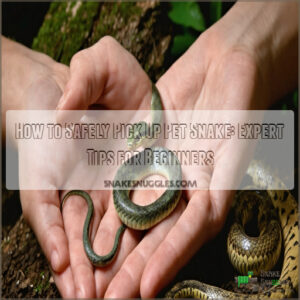
Like a graceful dance, approach slowly from the side and support your snake’s mid-body – never grab the head or tail. You’ll want to gently lift while letting your snake’s body rest across your palm.
Think of it as cradling a living bracelet. Keep movements smooth and deliberate, avoiding sudden gestures that might startle your scaly friend.
A snake hook can provide extra confidence for beginners. Remember, each snake has its own personality, and understanding these unique quirks makes handling a breeze.
Table Of Contents
- Key Takeaways
- Pre Handling Techniques
- Safely Picking Up Snakes
- Handling Techniques and Safety
- Snake Behavior and Handling
- Post Handling Procedures
- Frequently Asked Questions (FAQs)
- How do you handle a pet snake?
- Can you pick up a pet snake by its head?
- How do you acclimate a pet snake?
- How do you pick up a snake?
- Can you pick up a rattlesnake by the tail?
- Can you pick up a venomous snake by hand?
- How should you pick up a pet snake?
- What is the correct way to pick up a snake?
- What is the correct way to hold a snake?
- Is it safe to pick up a snake?
- Conclusion
Key Takeaways
- Wash your hands with unscented soap before handling to remove scents and prevent bacteria transfer.
- Approach your snake calmly and slowly, supporting its mid-body with both hands while avoiding the head and tail.
- Avoid handling your snake during shedding or feeding times as it’s more prone to stress or defensive behavior.
- Return your snake gently to its enclosure and secure all locks to prevent escape.
Pre Handling Techniques
Before handling your snake, wash your hands to remove any scents or bacteria that could confuse or harm it.
Create a calm, secure environment to guarantee the snake feels safe and less likely to react defensively.
Washing Hands Before Handling
Before picking up your pet snake, proper cleanliness is key. Hand hygiene prevents bacteria transfer and makes sure safety.
Wash hands thoroughly to remove germs and scents that might confuse your snake. Here’s how:
- Use unscented soap for germ removal.
- Rinse with warm water.
- Dry hands well.
- Avoid lotions or perfumes.
Using unscented soap products is important for effective hand cleaning. Stay consistent—snake safety depends on it.
Acclimating Snake to Human Presence
Building snake trust starts with a calm approach and slow introduction.
Let the snake get used to your human scent by resting your hand in its enclosure for a few minutes daily.
Avoid sudden movements; instead, use a gentle touch. Consistency helps establish confidence and improves safe snake handling techniques.
With patience, handling pet snakes safely becomes second nature.
Creating a Calm Environment
To create a calm environment, choose a quiet area free from loud noises or distractions.
Soft lighting sets a peaceful atmosphere, helping your snake feel secure. Use a gentle approach with slow movements to avoid startling it.
A calm space allows for safe snake handling techniques, ensuring the snake recognizes your presence and feels comfortable before a gentle lift.
By following proper snake handling methods, you can reduce stress and create a safe interaction.
Secure Enclosure and Designated Handling Area
A secure enclosure with thoughtful cage design sets the stage for safe snake handling.
Use a designated handling table to keep everything stable and organized. Snake restraints help during trickier situations.
For escape prevention, guarantee safety measures like tight lids and locks.
- Choose an escape-proof enclosure with locks.
- Use a clear, clutter-free handling table.
- Store tools like snake hooks within reach.
Safely Picking Up Snakes
When it’s time to pick up your snake, approach slowly and calmly.
Fast movements can stress the animal.
Always support its body by gently lifting it from the middle, keeping one hand on the first third and the other under the last quarter.
Avoid grabbing its head or tail, as this could frighten or harm it.
For added safety, consider using a snake hook, especially if your snake seems nervous.
Understanding snake handling safety is essential for both your well-being and the snake’s.
Never handle venomous species unless you’re an expert.
Gentle lifting is key—let the snake stabilize on your arms and don’t squeeze.
If the snake hisses or coils defensively, give it space.
These snake handling tips guarantee both your safety and your pet snake’s comfort, creating a smoother experience.
Handling Techniques and Safety
Handling your snake safely means supporting its body and avoiding sudden movements that could scare it.
With tools like snake hooks and a gentle touch, you can make the experience stress-free for both you and your pet.
Supporting Snake’s Body
When lifting your pet snake, always aim for a gentle grip around its mid-section while supporting the body with both hands.
A secure hold provides proper support, letting the snake feel safe.
Remember to practice safe snake handling techniques to minimize stress and prevent injury.
Avoid grabbing the head or tail, as this can stress or harm it. A gentle lift with steady hands shows you know how to handle pet snakes safely.
Avoiding Sudden Movements
When picking up a snake safely, avoid sudden movements—it’s like easing into cold water.
A slow approach keeps the snake calm. Gentle handling with quiet movements reassures them, as snakes can interpret jerky actions as threats.
Maintain a calm environment and use a soft touch to build trust. Gentle movements make safe snake picking up a smooth process.
Using Snake Hooks and Tongs
When handling snakes safely, a snake hook is your best friend. It’s perfect for lifting without startling.
Use tongs handling during feeding or for venomous restraint. For safe and humane handling, explore these recommended snake handling tools.
Slide the hook gently under the midsection, supporting the weight. Avoid grabbing the head or tail directly. This simple hook technique guarantees safe snake picking up, keeping you and your pet secure.
Applying Gentle Pressure
When picking up a pet snake, use a gentle grip and soft touch.
Avoid squeezing; calm handling builds trust. Slow lifting with full body support makes sure the snake feels secure.
Gentle movements are key—abrupt actions can startle them.
If you’re wondering how to pick up a snake safely, staying steady and mindful is your best bet for safe pet snake handling.
Snake Behavior and Handling
Understanding your snake’s body language is key to safe handling. Pay attention to its movements and mood to know when it’s ready to interact.
Recognizing Snake Body Language
A snake’s body language says a lot.
Relaxed snake posture with smooth, natural movements signals calmness.
Coiling behavior, a raised head suggests caution. Watch for tail signs like wagging, which can mean stress.
Understanding snake body language is essential for safe handling.
Eye contact and steady tongue flicking show curiosity, not aggression. Recognizing these cues helps you adjust handling techniques and avoid missteps.
Identifying Venomous Species
Recognizing a venomous snake can save your skin—literally! Key features include a triangular head and slit-like pupils.
Familiarize yourself with these signs to stay safe:
- Venomous Signs: Triangular heads, thick bodies, or rattles.
- Snake ID Tip: Learn local snake species.
- Hazard Recognition: Avoid unknown snakes.
- Venom Detection: Bright warning colors.
- Handling Venomous Snakes: Use tools, never hands.
Proper equipment like a Venomous Snake Kit is essential for safe handling.
Avoiding Handling During Shedding or Feeding
The shedding process and feeding times are when your snake feels most vulnerable, so avoid handling them then.
Stress peaks during shedding, as vision blurs, and during feeding, when instincts take over. Handling risks grow if ignored. Practice safety precautions by letting them rest.
Safe snake interaction always means knowing when to give your pet space.
| Situation | Snake Response | Your Action |
|---|---|---|
| During Shedding | Irritability, hiding | Avoid picking up |
| Feeding Time | Hyper-focused, striking | Don’t disturb |
| Blurry Vision Period | Defensive behavior | Skip interaction |
| Pre-Shedding | Lethargy | Create a calm enclosure environment |
| Post Feeding | Hunting reflex active | Wait a few hours before handling |
Maintaining Confident and Consistent Handling
When you’re picking up a pet snake, staying steady matters.
A calm demeanor and handler confidence help build snake trust.
Always use a secure grip and a gentle touch, giving the snake time to adjust.
Think of it as guiding, not controlling.
Safe snake handling is about consistent interaction.
Nervous hands? Snakes can sense it—stay cool.
Post Handling Procedures
After handling your snake, return it gently to its enclosure to prevent stress or injury. Always wash your hands thoroughly to reduce the risk of spreading germs like salmonella.
Returning Snake to Enclosure
After safe handling, gently lower the snake into its enclosure, letting it crawl off your hands naturally.
Use a calm touch for smooth Snake Release. Make sure the Enclosure Preparation is in place—objects stable, space clear.
Secure the lid tightly to prevent escape. Handling pet snake safely ends with attentiveness, as even expert handling guides prioritize escape prevention.
Washing Hands After Handling
Why should you wash your hands after handling your pet snake?
It’s not just about hand hygiene – snakes can carry salmonella and other bacteria that you don’t want to spread around your home.
Once you’ve returned your snake to its enclosure, head straight to the sink.
Use warm water and soap, scrubbing thoroughly for at least 20 seconds to make sure proper germ prevention.
Cleaning and Maintaining Snake Enclosure
Regular enclosure cleaning keeps your snake’s home a healthy haven. You can find effective snake enclosure cleaners.
Remove waste daily and do a deep clean weekly, using pet-safe disinfectants to sanitize surfaces. Maintain proper humidity levels by misting when needed, and replace substrate monthly.
Check temperature gradients regularly, ensuring the basking spot and cool side remain at ideal levels. Don’t forget to inspect for mold or bacteria growth, which is crucial for maintaining a clean environment and preventing the spread of disease.
Preventing Escape and Ensuring Snake Safety
Every snake is a master escape artist, so proper containment is essential for their safety.
When returning your pet to its enclosure, double-check that all latches are secure and any gaps are sealed.
For maximum snake handling safety:
- Install backup locks on sliding doors
- Use clips to secure screen tops
- Seal any gaps larger than 1/4 inch
- Check temperature controls are working properly
Remember, gentle restraint and a calm environment prevent stress-induced escape attempts.
Frequently Asked Questions (FAQs)
How do you handle a pet snake?
Support your snake’s body with both hands, one-third down from its head. Move slowly and confidently. Let it wrap around your arms for stability. Don’t grab the head or tail.
Can you pick up a pet snake by its head?
Like picking up a snake by its teeth, grabbing your pet snake’s head is dangerous and stressful for them.
You shouldn’t do it – instead, gently support their mid-body with both hands.
How do you acclimate a pet snake?
Spend a few minutes twice daily letting your hand rest in the snake’s cage.
This helps it get used to your scent.
Keep movements slow and gentle while maintaining a clean, calm environment.
How do you pick up a snake?
Just as a dancer moves with grace, lift your snake gently from its mid-section.
Use both hands to support its body, letting it wrap around your arms.
Don’t grab the head or tail.
Can you pick up a rattlesnake by the tail?
Never pick up a rattlesnake by the tail – it’s extremely dangerous and could get you killed.
You shouldn’t handle venomous snakes at all unless you’re a trained professional with proper equipment.
Can you pick up a venomous snake by hand?
You’d have to be completely out of your mind to pick up a venomous snake by hand.
Don’t attempt it – even trained professionals use specialized tools.
Contact animal control instead to handle dangerous snakes.
How should you pick up a pet snake?
Support your snake’s body with both hands – one third down and one near the tail.
Move slowly, stay calm, and let it stabilize on your arms.
Don’t grab the head or tail.
What is the correct way to pick up a snake?
Think of picking up a snake like handling a delicate treasure—approach calmly, lift from the middle, and support its body with both hands.
Avoid its head and tail.
Stay gentle, steady, and confident.
What is the correct way to hold a snake?
Hold the snake gently but firmly, supporting its body with both hands.
Let it wrap around your arms for stability.
Avoid squeezing, sudden movements, or grabbing its head.
Stay calm, and let it move naturally.
Is it safe to pick up a snake?
Picking up a snake is like meeting someone new—approach calmly and let it adjust to you.
Support its body with both hands, avoid the head and tail, and stay relaxed to provide safety for both.
Conclusion
Picture handling your pet snake like guiding a ribbon in the wind—steady, calm, and controlled.
Always approach with clean hands in a quiet space, supporting its body to avoid stress. Understand its behavior and use tools like a snake hook if needed.
Avoid handling during shedding or feeding to keep things safe for both of you.
Mastering how to safely pick up a pet snake takes patience, practice, and respect, ensuring a smooth, enjoyable experience for you and your snake.
- https://www.wikihow.com/Hold-a-Snake
- https://www.reddit.com/r/herpetology/comments/135s1jt/how_to_properly_pick_up_a_snake/
- https://www.reptileknowledge.com/reptile-pedia/what-happens-if-you-pick-up-a-snake
- https://www.evolutionreptiles.co.uk/blog/handling-snakes/
- https://www.msdvetmanual.com/exotic-and-laboratory-animals/reptiles/clinical-procedures-for-reptiles

